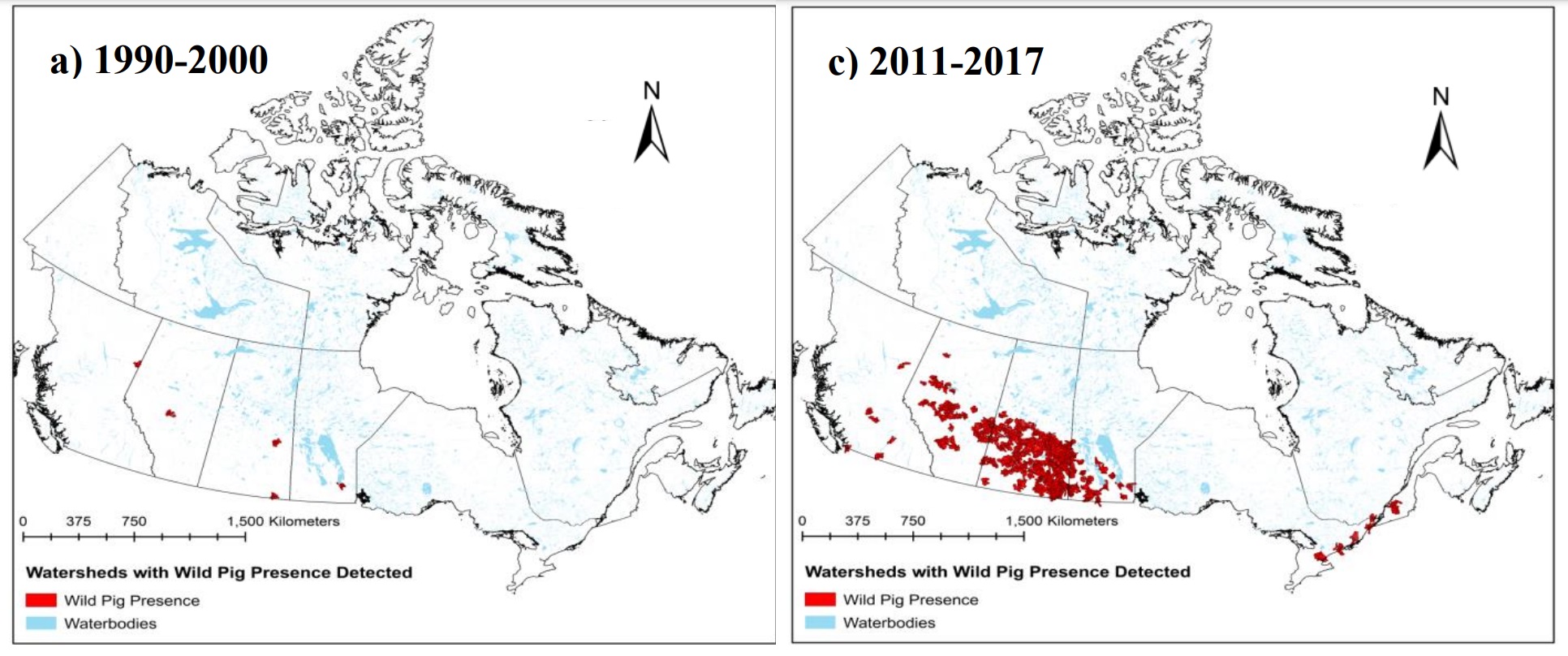Hybrid hogs — a genetic blend of wild boars and domestic pigs — rocked up in Canadian farms around 30 years ago in an attempt to spice up the country’s livestock produce. Over the past three decades, countless numbers of them have escaped and bred like crazy, earning themselves the title of the most prolific invasive mammal in Canada.
The wild pigs are the descendants of domestic pigs (Sus scrofa domesticus), Eurasian wild boar (S. scrofa scrofa), or hybrids of the two.
As their name suggests, Eurasian wild boars and their domesticated subspecies are not native to North America but were introduced by European settlers in the 16th century. Over the next four centuries, many more were introduced into parts of the US and Canada for sport hunting, before being let loose into the wild.
The problem of wild pigs truly took off in the late 1980s and early ’90s when farmers started to domesticate boar hybrids to diversify Canada’s livestock production. Taking inspiration from Europe, farmers would typically breed male wild boars with female domestic pigs, aiming to create an “Iron Age pig” that had similar qualities as early livestock that were first domesticated by humans in ancient times.
The resulting pigs were quite remarkable: they were super-smart, large, purportedly delicious, and perfectly suited for the harsh Canadian winters. However, the market for boar pork delicacies slumped, so herds of the hybrids were let loose into the wild. Many more escaped their captivity using their keen senses and intelligence.
They proved to be a formidably invasive species. The wild pigs hunted native animals, such as turkeys and game birds, and preyed on young livestock like lambs, kids, and calves. Simultaneously, they would strip the land of berries, roots, bark, and any form of vegetation, leaving little for grazing animals and black bears.
On top of that, wild pigs are the hosts of over 30 significant viral and bacterial pathogens, as well as more than 37 species of parasites, which can pose a threat to humans and other animals.

Two maps show the growth of wild pig populations in Canada between 1990-2000 compared to 2011-2017.
Image credit: University of Saskatchewa
As prolific breeders with a lack of natural predators, their numbers were able to boom rapidly. A 2019 study found that the wild pig population in Canada was increasing by 9 percent a year. As per the research, the wild pigs command a range of over 750,000 square kilometers (289,576 square miles), which has increased by 88,000 square kilometers (33,976 square miles) per year over the last decade.
“Wild pigs are ecological train wrecks. They are prolific breeders making them an extremely successful invasive species,” said study author Ruth Aschim in a statement at the time.
“The growing wild pig population is not an ecological disaster waiting to happen—it is already happening,” added Ryan Brook, lead researcher for the Canadian Wild Pig Project.
“This is a rapidly emerging crisis.”
Some provinces of Canada have taken action against the invasion. As of January 1, 2024, the importation, possession, transport, propagation, buying, selling, and trading of live Eurasian wild boar and their hybrids is banned in Ontario, according to the local government. This includes any animal that is genetically greater than 25 percent Eurasian wild boar.
Over in Alberta, provincial governments have rolled out a program for the public to report sightings of feral pigs and the damage they have left behind. Before this, the province ran an initiative where hunters could turn in a set of wild boar ears and receive a $50 bounty – but the plan backfired.
“What happens is if a hunter goes in and removes one or two individuals, the remaining pigs learn from that experience to avoid humans. They will avoid being hunted or trapped by humans – they’ll go nocturnal, they’ll disperse,” Megan Evans, executive director of the Alberta Invasive Species Council, said in 2021.
“These are really smart animals, we all know how smart pigs are and these are wild boar, so they are smarter than domestic pigs. And they will actually teach (those behaviours) to their offspring,” noted Evans.
Canada’s pig problem still squeals on, but they are not alone in their woes. A recent report estimated that there are over 37,000 invasive species worldwide, with 200 new ones recorded each year. Many of them present a serious danger to wildlife, human health, and food security – and just like Canada’s feral hogs, there are no easy solutions.
Source Link: Hybrid Hogs Are Raising Hell In Canada's Southern Provinces